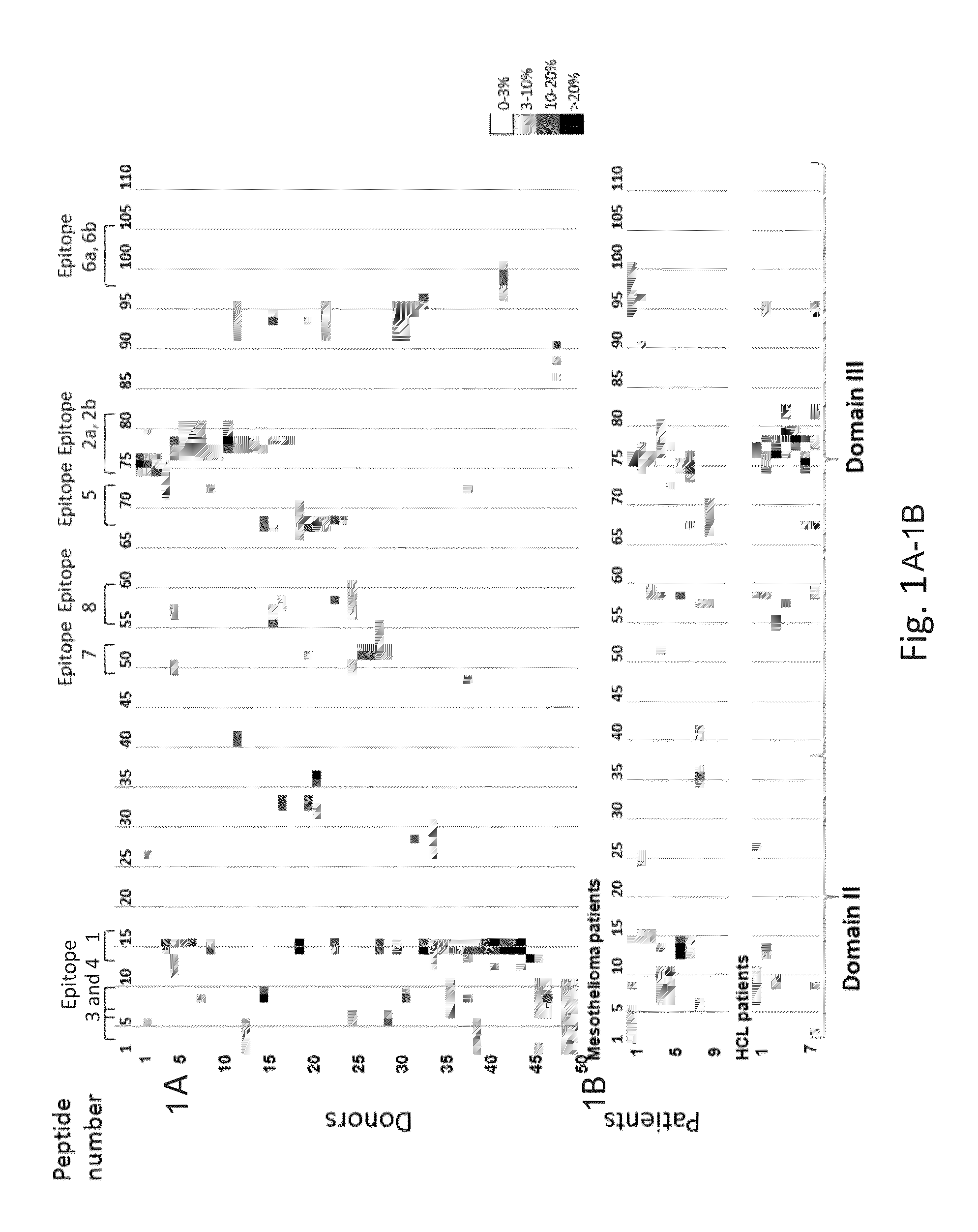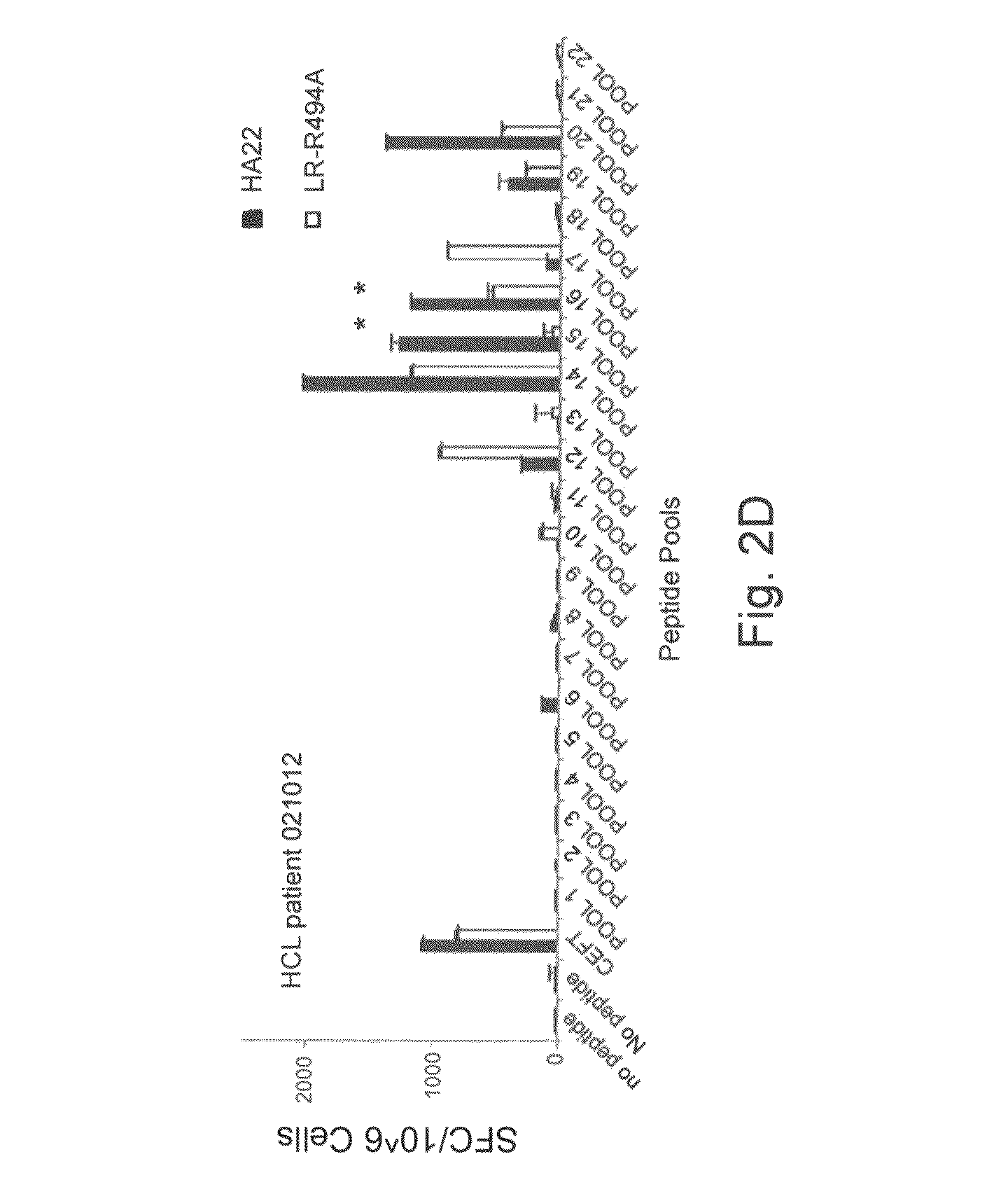Modified Pseudomonas exotoxin A
a technology of pseudomonas and exotoxins, which is applied in the direction of peptide/protein ingredients, fusions for specific cell targeting, antibody medical ingredients, etc., can solve the problems of reducing the effectiveness of pe for treating disease, etc., to achieve the effect of optimizing treatment schedule, enhancing serum half life, and reducing side effects
- Summary
- Abstract
- Description
- Claims
- Application Information
AI Technical Summary
Benefits of technology
Problems solved by technology
Method used
Image
Examples
example 1
[0354]This example demonstrates the identification of T cell epitopes in domain III of PE38.
[0355]To identify the T cell epitopes in PE38, peripheral blood mononuclear cells (PBMCs) were first incubated with a recombinant immunotoxin (RIT) for 14 days to allow the RIT to be processed by donor APCs to relevant peptides to be presented to T cells. The enriched PBMCs were subsequently exposed to a peptide library composed of 111 partially overlapping peptides spanning the sequence of PE38 and T cell activation was measured using an ELISpot assay for interleukin-2 (IL-2).
[0356]Samples from 50 normal donors with no recorded previous exposure to PE38 and with a broad distribution of human leukocyte antigen (HLA) alleles were analyzed. The cells of this population contained naïve T cell epitope. Samples from nine mesothelioma and seven hairy cell leukemia (HCL) patients that were previously treated with PE-based RIT and who had developed high levels of neutralizing antibodies were also ana...
example 2
[0365]This example demonstrates the elimination of T cell epitopes in domain III.
[0366]For each one of the epitopes in domain III that are described in Table 1, alanine scanning mutagenesis was performed. The alanine mutant was incorporated into the RIT according to the following 11 steps: (1) a list was made of all alanine peptide variants for each epitope; (2) in silico prediction was performed to rule out alanine variants that had increased binding to at least six HLA alleles using an HLA binding algorithm (Immune Epitope Database, IEDB) (Wang et al., PLoS Comput. Biol., 4:e1000048 (2008)) that measured their ability to bind to 13 major HLA groups; (3) alanine variants were assayed using 8-15 donors and patient samples with in vitro expansion and ELIspot; (4) an alanine mutation with diminished T cell activation was identified; (5) the alanine mutation was cloned into the HA22-LR plasmid, and a RIT was constructed with a single point mutation; (6) activity was studied using the W...
example 3
[0377]This example demonstrates the cytotoxic activity of point mutation proteins in HA22-LR.
[0378]Step 4 of Example 2 was carried out. The best variants identified in the alanine scan or using further in silico prediction are described in Table 1A.
[0379]Forty mutant RITs were constructed. The cytotoxic activity of point mutation proteins in HA22-LR was evaluated with respect to CA46, Raji, and Daudi cells. Yields of purified protein, calculated accessible surface areas (Lee et al., J. Mol. Biol., 55:379-400 (1971); Roscoe et al., Infect. Immunity, 62:5055-5065 (1994)) of WT amino acids residues and cytotoxic activity of each RIT are shown in Table 8.
[0380]
TABLE 8Protein activityProteinMean relativeASAyieldactivity (%) ± SDPeptideMutation(Å2)*(mg)CA46RajiDaudi76R500A0A76L498A4A76L499A0.1A76R494A352.021 ± 3 33 ± 1036 ± 8 76R494D353.231177R505A150478 ± 13185 ± 10676 / 77Y502A0A76 / 77Y502H0A76 / 77Y502F0A76 / 77Y502K0A67I471A41.62467I471V448310867I471M43367I471H4A67I471G4A67I471S41.3267I471D4...
PUM
| Property | Measurement | Unit |
|---|---|---|
| nucleic acid | aaaaa | aaaaa |
Abstract
Description
Claims
Application Information
 Login to View More
Login to View More - R&D
- Intellectual Property
- Life Sciences
- Materials
- Tech Scout
- Unparalleled Data Quality
- Higher Quality Content
- 60% Fewer Hallucinations
Browse by: Latest US Patents, China's latest patents, Technical Efficacy Thesaurus, Application Domain, Technology Topic, Popular Technical Reports.
© 2025 PatSnap. All rights reserved.Legal|Privacy policy|Modern Slavery Act Transparency Statement|Sitemap|About US| Contact US: help@patsnap.com



